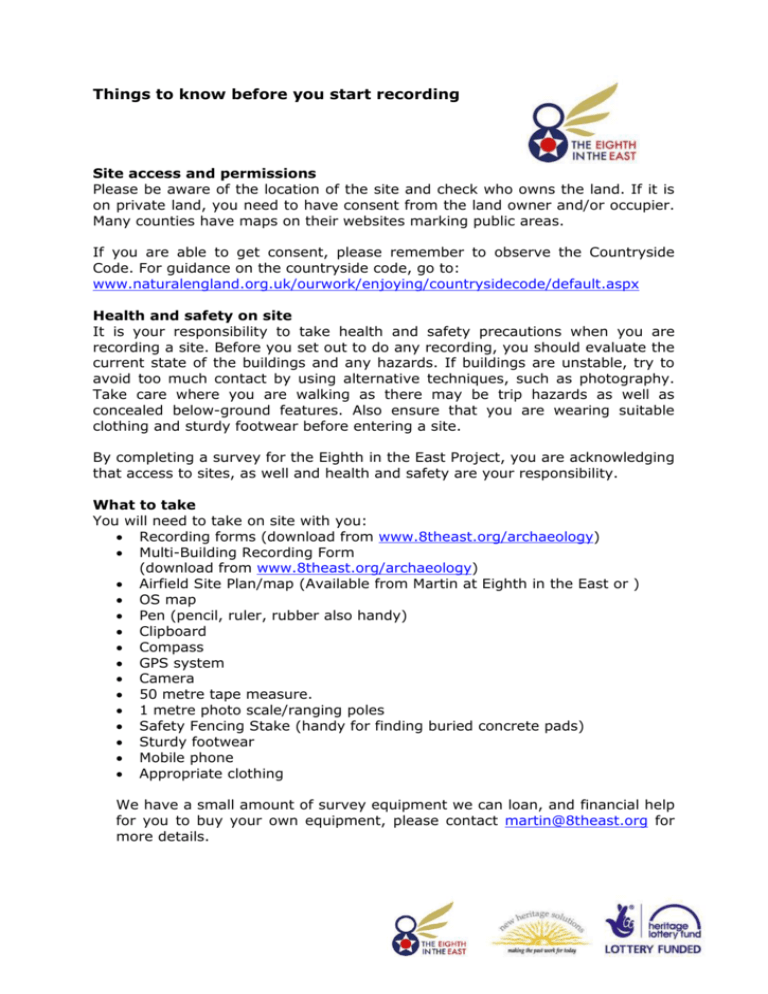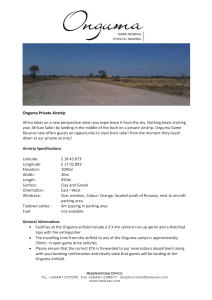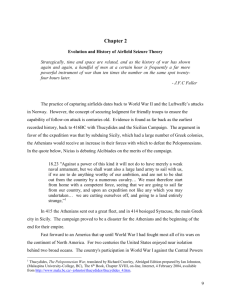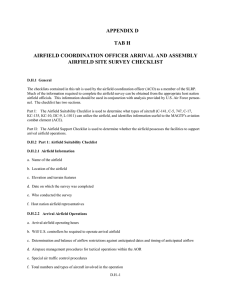Recording Form Instruction-EITE
advertisement

Things to know before you start recording Site access and permissions Please be aware of the location of the site and check who owns the land. If it is on private land, you need to have consent from the land owner and/or occupier. Many counties have maps on their websites marking public areas. If you are able to get consent, please remember to observe the Countryside Code. For guidance on the countryside code, go to: www.naturalengland.org.uk/ourwork/enjoying/countrysidecode/default.aspx Health and safety on site It is your responsibility to take health and safety precautions when you are recording a site. Before you set out to do any recording, you should evaluate the current state of the buildings and any hazards. If buildings are unstable, try to avoid too much contact by using alternative techniques, such as photography. Take care where you are walking as there may be trip hazards as well as concealed below-ground features. Also ensure that you are wearing suitable clothing and sturdy footwear before entering a site. By completing a survey for the Eighth in the East Project, you are acknowledging that access to sites, as well and health and safety are your responsibility. What to take You will need to take on site with you: Recording forms (download from www.8theast.org/archaeology) Multi-Building Recording Form (download from www.8theast.org/archaeology) Airfield Site Plan/map (Available from Martin at Eighth in the East or ) OS map Pen (pencil, ruler, rubber also handy) Clipboard Compass GPS system Camera 50 metre tape measure. 1 metre photo scale/ranging poles Safety Fencing Stake (handy for finding buried concrete pads) Sturdy footwear Mobile phone Appropriate clothing We have a small amount of survey equipment we can loan, and financial help for you to buy your own equipment, please contact martin@8theast.org for more details. Choosing a site Before filling in your recording form you will need to choose a site that you have permission to access. You need to use one form per building. If there are several buildings on one site, you must use more than one form. You will also need to do some basic desk based research in the background of the structure. This could include gaining local knowledge, looking at books about the site, or at the local Historic Environment Records. These Historic Environment Records (HER) can often be found on County Council websites, or on: www.heritagegateway.org.uk/gateway/CHR Demolished sites If a site you want to record has been demolished, or only concrete bases remain please fill out one of our Multi Building Recording Form, one sheet can be used per Sub Site. Make a note of any remains such as crop markings (Google Earth or Google Maps can be useful for this) or if there seems to be any scope for buried archaeological deposits. If just foundations remain, please make a note of this. How to fill in your recording form Reference The reference at the top of each page needs to be individual to each form. It should be the airfield name followed by your surname and the number of the survey. For example if you have conducted the survey at Hethel airfield, your name is John Smith, and this is your 4th survey of a building at that airfield, your reference would be HETHEL/SMITH/4. Internal Reference The internal reference will be filled in by the relevant HER. You do not need to fill this in. Location Official name of the airfield and alternative names This is the name of the airfield as it appears on the airfield plan. If you know of any other names it is known as more locally, please make a note of them as well. Name of sub site This information can be found on the airfield plan. (e.g. site 5 or communal site 1). If you do not know the name of a site, please write ‘unknown’. Building number and building use/function This information can be found on the airfield plan key. (e.g building 1 is a Picket Post) Drawing Number (DRG or DWG number.-on airfield plan key) This information can be found on the airfield plan key. The Drawing Number is the reference for the actual blueprint drawing of that structure. The blueprint is a separate drawing held at the RAF museum in Hendon, London. Ordnance Survey (OS) Coordinates Include the OS coordinates of the structure. Either use GPS equipment or download a free OS coordinate app to your phone. The app is free to download and free to use. You just need to turn on the GPS on your phone. (It doesn’t need 3G to work) Android phones: search Play Store for “Grid Reference” by Arthur Embleton. After you have downloaded click on settings, in the app, and switch to 10 figures. I- phone: Or have a look on www.gridreferencefinder.com Address and County If you know the address and/or postcode for the site, please make a note of this. The county should also be included to ensure the completed form gets to the correct HER. Location notes/directions Please fill in this if you are unsure of the OS coordinates. Describe where the site is in relation to local villages, the roads it is on, or its position in the landscape. This short description should enable people to find the site without using a map. If you do have a copy of the airfield plan, it is a good idea to highlight the building being surveyed, and attaching a copy of this plan to your finished form so it is easily identifiable. Site Observations Type of Structure Please tick the type of structure your building is and include the type. These can be found on the key of the airfield plan. If you think the building is labelled on the airfield plan incorrectly or there is more information in the key, please discuss this further in the Site Description box. Control Tower Hangar/Aircraft shed Hut o Nissen hut o Romney hut o Orlit hut o Seco hut o Thorn hut o Other (please specify) Temporary brick Pillbox/airfield defences Air raid shelter o Blast shelter o Stanton shelter o Other (please specify) Bomb stores Other brick structure Other concrete structure Other steel structure Other wooden structure Site description and features It is in this part of the form that you can describe your site with more detail. Is there anything to suggest that this building is not what is labelled on the site plan or had an alternative use? You also need to try to accurately describe what is left on the site and how it looks now, referencing the shape of structures, as well as any interesting features. A short summary is enough to record a site, but if you prefer, use the continuation sheet to include a more detailed description. It is important to cover the following points: Location: topography (flat, sloping, terraced), proximity to other structures Outer Walls (construction materials) Room divisions/internal walls: (construction materials) Roofing and joists: (construction materials/shape) Special Features: Are there any distinctive features? Doorways, windows, graffiti, remaining paint Phasing: Features of an earlier or later building such as blocked up windows and doorways Dimensions: If possible, the height and breadth of a building and thickness of walls (metric) Orientation: north, south, east or west orientation of the site and structure Shapes: The shape of the building, the types of corners Overall condition of each element This is based on your judgement, but will provide an insight into the physical remains of the building. Please use the following as a guide before you circle your chosen options. Good – Fully or almost full intact at time of survey Fair – Recognisable as a structure but some evidence of damage , decay or alterations Poor – Generally in a poor condition with significant features largely missing Very poor – Substantial collapse or features completely missing Uncertain – Features of interest not able to be surveyed at the time (obscured by undergrowth etc.) Destroyed – Little or no remains still visible above ground and no further information can be obtained from future investigation of the site Current Use Please select what the building is currently being used for from the following: None – The building is empty Destroyed – The building is no longer standing Derelict – The building has been abandoned and it not it good condition Vacant – The building is not in bad condition but is currently empty Residential – The building is being used as housing Leisure – The building is being used for leisure purposes Museum – The building is being used to house a museum Military – The building is being used by the military Agricultural – The building is being used in agriculture Industrial/commercial – The site being used as part of large scale production or for trading Other – If the site does not fall into any of the categories, please select ‘other’ and make a note of its use Images For each building you will need to take a number of photos. These should illustrate the most important aspects of the building/features recorded at that location. You will need to include the file name (see below) and a short description of what is included in the photo. What to photograph It is important when photographing to first think about what you think needs to be documented. A suitably sized scale is always useful. If possible, please use a ranging pole as a scale for larger shots, and a smaller one for details. If you would like to borrow a set of scales, please email Martin at martin@8theast.org. You will need to label the location of all your photographs on your plan of the building. For well-preserved buildings, you should aim to take photographs of the following: A general view of the building in its wider setting or landscape The outside of each side of the building showing the elevations of the building. These photos should give an overall impression of the size and shape of the building. In order to do this, you should aim to take photos not face on, but more indirectly at a slight angle. A photo of the main rooms or spaces inside the building Any detail on the outside or inside of the building that is structural or decorative. This should include details of the roof structure, details of any windows or doors, and any changes in construction materials or techniques. Any features that may indicate the use of the building during American use Any graffiti, drawings, paintings, signage or inscriptions that is still visible around the building. A transcription should also be made of any such writing on the continuation sheet. Anything around the building that have significant bearing on the buildings history (such as hanging mounts, locations of old fittings) that are not sufficiently covered in other photographs Uploading your photographs When you upload your photos to the computer from a digital camera, you will need to ensure they are either saved as a JPEG of TIFF format. Usually images automatically save as a JPEG. If you are saving in TIFF format, please insure they are at a minimum of 300dpi and no larger than 1200 x 1800 pixels. You may need to then compress the files so they are no larger than 8Mb. When naming your digital photographs, please use the following format: [airfield]_EITEsurvey_[surname]_[record form number]_[photo number]_[YYYY] For example, if your name is John Smith and you have undertaken your 4th survey of buildings at Hethel airfield during 2014, your first photo will be saved as: Hethel_EITEsurvey_smith_4_1_2014 Site Drawings A sketch of the site, building location, and building itself can also be useful. This can be a rough sketch or contain more detail, depending on how much time you have. If you are drawing a plan of the building as it looking from it above, measurements can be included. Similarly, if you draw the elevation of the side of a building it is helpful to include measurements of walls, doorways, windows etc. in cm and meters. You should also include the locations and direction of each photograph you took. Copyright Copyright for data produced during Eighth in the East led surveys will be held by New Heritage Solutions C.I.C, with the relevant HER and/or English Heritage being the ultimate repository of this information. Owners retain copyright of any archive reference material including archive materials, photographs and moving images. However the sharing of this information allows the rights for New Heritage Solutions C.I.C to use the material and to share this information with their partners and other interested bodies. New Heritage Solutions C.I.C is the community interest company who deliver The Eighth in the East on behalf of the Heritage Lottery Fund. What Next? Ideally we would like you to send us digital scanned copies of your forms and email this to us, complete with digital photos and scans of any other documents. Please send your finished form to martin@8theast.org Or email martin for the Eight in the Easts own Dropbox cloud login details to transfer photos and recording forms digitally. If you are unable to do this, it is possible to post your form to the following address, whilst emailing or Dropboxing your photos. Martin Cuthbert The Eighth in the East Office 18 Red Gables Ipswich Road Stowmarket Suffolk IP14 1BE These will then be added to the relevant Historic Environment Record to be used for future research, and to monitor the legacy the 8th Air Force left behind. For more help completing this form, or for any comments, please email martin@8theast.org Helpful websites http://www.8theast.org/ http://www.heritagegateway.org.uk/gateway/advanced_search.aspx http://www.historicengland.org.uk/listing/the-list/ http://www.americanairmuseum.com/ http://www.airfieldinformationexchange.org/community/forum.php http://www.gridreferencefinder.com/ http://www.bing.com/mapspreview?FORM=Z9LH3 turn on Ordnance survey view Helpful books (available from your local library) Airfields of the Eighth - Then and Now, Roger Freeman 1978 British Airfield Buildings of the Second World War, Graham Buchan Innes, 2000 British Military Airfield Architecture, Paul Francis, 1996 20th Century Defences in Britain – An Introductory Guide, Ed. B Lowry, 1995, CBA handbook 12.








